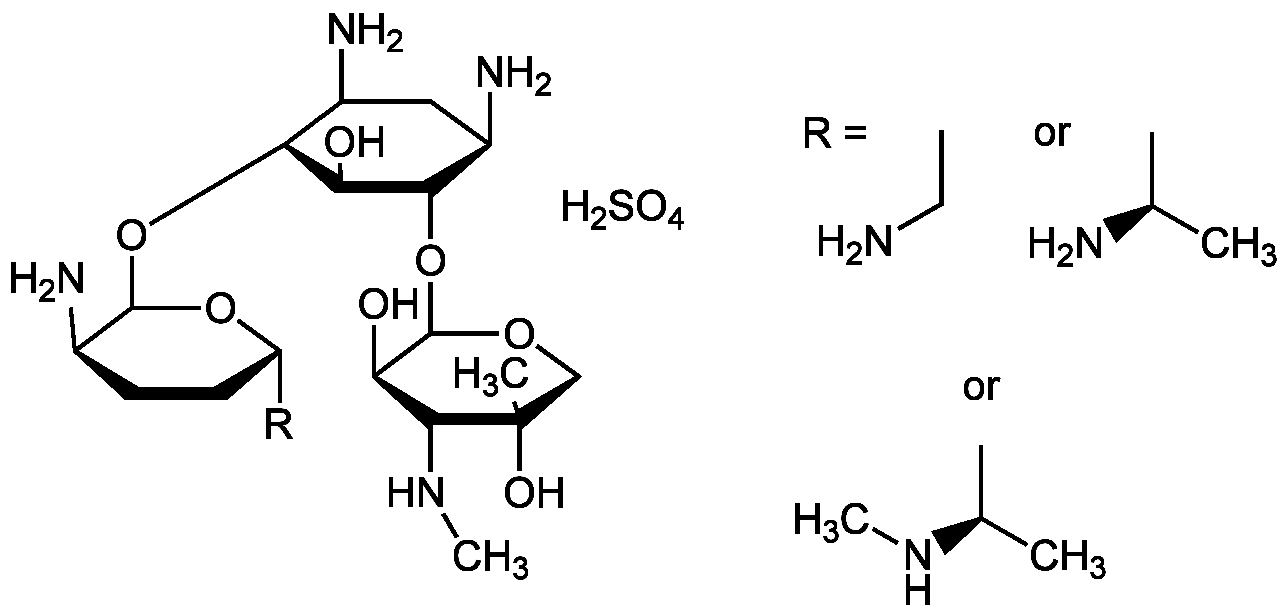Gentamicin sulfate (USP Grade)
Product Code: AG-CN2-0066
Product Group: Natural Products and Extracts
Supplier: AdipoGen Life Sciences
| Code | Size | Price |
|---|
| AG-CN2-0066-G001 | 1 g | £40.00 |
Quantity:
| AG-CN2-0066-G005 | 5 g | £130.00 |
Quantity:
| AG-CN2-0066-G025 | 25 g | £370.00 |
Quantity:
Prices exclude any Taxes / VAT
Overview
Regulatory Status: RUO
Shipping:
Ambient
Storage:
+4°C
Images
Documents
Further Information
Alternate Names/Synonyms:
Apogen; Garamycin; Gentiomycin C; Refobacin; NSC-82261
Appearance:
White to off-white powder.
Biological Activity:
Potency (dry basis) >590µg/mg
CAS:
1405-41-0
EClass:
32160000
Form (Short):
liquid
GHS Symbol:
GHS08
Handling Advice:
Hygroscopic.Keep cool and dry.
Hazards:
H317, H334
InChi:
InChI=1S/C19H39N5O7.H2O4S/c1-19(27)7-28-18(13(26)16(19)24-2)31-15-11(23)5-10(22)14(12(15)25)30-17-9(21)4-3-8(6-20)29-17;1-5(2,3)4/h8-18,24-27H,3-7,20-23H2,1-2H3;(H2,1,2,3,4)/t8-,9+,10-,11+,12-,13+,14+,15-,16+,17+,18+,19-;/m0./s1
InChiKey:
HNCAOLPMSASREN-UCMBPTNBSA-N
Long Description:
Chemical. CAS: 1405-41-0. Formula: C21H43N5O7 . H2SO4 (unspecified). MW: 575.6. Isolated from Micromonospora sp. Aminoglycoside antibiotic. Protein synthesis inhibitor. Causes codon misreading by binding to the 30S ribosomal subunit, blocking the translocation of peptidyl-tRNA from the acceptor site to the donor site. Antibacterial against Gram-negative aerobic bacteria, Gram-positive bacteria and mycoplasmas. Used as a selection agent (gentamicin-resistance gene) in molecular biology applications. Broad-spectrum cell culture antibiotic that is nontoxic to viruses and mammalian cells at antibacterial and antimycoplasmal concentrations. Due to its extended stability and slow development of bacterial resistance, it is a useful antibiotic in long-term virus und tissue culture studies. Bactericidal effects are exerted by the binding to the outer membrane, causing disruption of the membrane. This increases the permeability of the cell envelope, leakage of cell contents, and leading to apoptosis and proteolysis (cell death). Causes also cell death by generation of free radicals, phospholipidosis, extracellular calcium-sensing receptor stimulation and energetic catastrophe.
MDL:
MFCD00270181
Molecular Formula:
C21H43N5O7 . H2SO4 (unspecified)
Molecular Weight:
575.6
Package Type:
Vial
Precautions:
P261, P302, P352, P304, P341
Product Description:
Aminoglycoside antibiotic. Protein synthesis inhibitor. Causes codon misreading by binding to the 30S ribosomal subunit, blocking the translocation of peptidyl-tRNA from the acceptor site to the donor site. Antibacterial against Gram-negative aerobic bacteria, Gram-positive bacteria and mycoplasmas. Used as a selection agent (gentamicin-resistance gene) in molecular biology applications. Broad-spectrum cell culture antibiotic that is nontoxic to viruses and mammalian cells at antibacterial and antimycoplasmal concentrations. Due to its extended stability and slow development of bacterial resistance, it is a useful antibiotic in long-term virus und tissue culture studies. Bactericidal effects are exerted by the binding to the outer membrane, causing disruption of the membrane. This increases the permeability of the cell envelope, leakage of cell contents, and leading to apoptosis and proteolysis (cell death). Causes also cell death by generation of free radicals, phospholipidosis, extracellular calcium-sensing receptor stimulation and energetic catastrophe.
Purity:
Mixture of gentamicin C1, C1a, C2, C2a and C2b.
Signal word:
Danger
SMILES:
CCN.CC(C)N.CNC(C)C.OS(O)(=O)=O.CN[C@H]1[C@@H](O)C(OC2[C@H](N)CC(N)[C@H](OC3O[C@H]([*])CC[C@H]3N)[C@H]2O)OCC1(C)O
Solubility Chemicals:
Soluble in water. Almost insoluble in alcohol or ether.
Source / Host:
Isolated from Micromonospora sp.
Transportation:
Non-hazardous
UNSPSC Category:
Natural Products/Extracts
UNSPSC Number:
12352200
Use & Stability:
Stable for at least 2 years after receipt when stored at +4°C.
References
Gentamicin: antibacterial activity, clinical pharmacology and clinical applications: M. Finland; Med. Times 97, 161 (1969) (Review) | Aminoglycoside uptake and mode of action--with special reference to streptomycin and gentamicin. I. Antagonists and mutants: R.E. Hancock; J. Antimicrob. Chemother. 8, 249 (1981) (Review) | Aminoglycoside uptake and mode of action-with special reference to streptomycin and gentamicin. II. Effects of aminoglycosides on cells: E. Hancock; J. Antimicrob. Chemother. 8, 429 (1981) (Review) | Gentamicin interaction with Pseudomonas aeruginosa cell envelope: N.L. Martin & T.J. Beveridge; Antimicrob. Agents Chemother. 29, 1079 (1986) | Surface action of gentamicin on Pseudomonas aeruginosa: J. Kadurugamuwa, et al.; J. Bacteriol. 175, 5798 (1993) | Leupeptin and E-64, inhibitors of cysteine proteinases, prevent gentamicin-induced lysosomal phospholipidosis in cultured rat fibroblasts: J.P. Montenez, et al.; Toxicol. Lett. 73, 201 (1994) | Gentamicin as gene therapy: F.C. Luft; J. Mol. Med. (Berl) 80, 543 (2002) (Review) | An integrative overview on the mechanisms underlying the renal tubular cytotoxicity of gentamicin: Y. Quiros, et al.; Toxicol. Sci. 119, 245 (2011) (Review)
Related Products
| Product Name | Product Code | Supplier | Colistin sulfate (USP Grade) | AG-CN2-0065 | AdipoGen Life Sciences | Summary Details | |||||||||||||||||||||||||||||||||||||||||||||||||||||||||||||||||||||||||||||||||||||||||||||
|---|---|---|---|---|---|---|---|---|---|---|---|---|---|---|---|---|---|---|---|---|---|---|---|---|---|---|---|---|---|---|---|---|---|---|---|---|---|---|---|---|---|---|---|---|---|---|---|---|---|---|---|---|---|---|---|---|---|---|---|---|---|---|---|---|---|---|---|---|---|---|---|---|---|---|---|---|---|---|---|---|---|---|---|---|---|---|---|---|---|---|---|---|---|---|---|---|---|---|---|
| Puromycin . 2HCl | AG-CN2-0078 | AdipoGen Life Sciences | Summary Details | ||||||||||||||||||||||||||||||||||||||||||||||||||||||||||||||||||||||||||||||||||||||||||||||||



